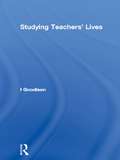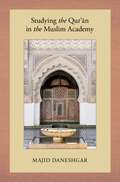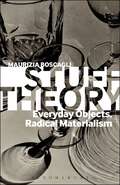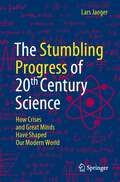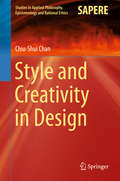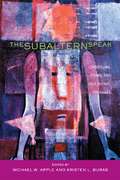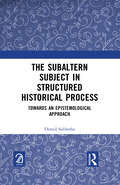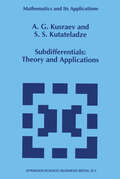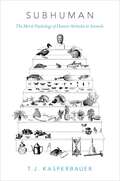- Table View
- List View
Studying Teachers' Lives (Investigating Schooling Series)
by I GoodisonTo develop a mode of educational research which speaks both of and to the teacher we require more study of the lives of teachers. This book provides a vital insight into the ways in which teachers' bakgrounds and career histories affect their teaching methods and approaches. Many issues are covered ranging from the question of teacher drop-out to the importance of teacher socialisation. The studies employ a range of different methodologies allowing the reader to assess their varying strengths and weaknesses, but throughout they reaffirm the centrality of the teacher in educational research.
Studying the Qur'an in the Muslim Academy (AAR Reflection and Theory in the Study of Religion Series)
by Majid DaneshgarStudying the Qur'an in the Muslim Academy examines what it is like to study and teach the Qur'an at academic institutions in the Muslim world, and how politics affect scholarly interpretations of the text. Guided by the author's own journey as a student, university lecturer, and researcher in Iran, Malaysia, and New Zealand, this book provides vivid accounts of the complex academic politics he encountered. Majid Daneshgar describes the selective translation and editing of Edward Said's classic work Orientalism into various Islamic languages, and the way Said's work is weaponized to question the credibility of contemporary Western-produced scholarship in Islamic studies. Daneshgar also examines networks of journals, research centers, and universities in both Sunni and Shia contexts, and looks at examples of Quranic interpretation there. Ultimately, he offers a constructive program for enriching Islamic studies by fusing the best of Western theories with the best philological practices developed in Muslim academic contexts, aimed at encouraging respectful but critical engagement with the Qur'an.
Studying the Qur'an in the Muslim Academy (AAR Reflection and Theory in the Study of Religion Series)
by Majid DaneshgarStudying the Qur'an in the Muslim Academy examines what it is like to study and teach the Qur'an at academic institutions in the Muslim world, and how politics affect scholarly interpretations of the text. Guided by the author's own journey as a student, university lecturer, and researcher in Iran, Malaysia, and New Zealand, this book provides vivid accounts of the complex academic politics he encountered. Majid Daneshgar describes the selective translation and editing of Edward Said's classic work Orientalism into various Islamic languages, and the way Said's work is weaponized to question the credibility of contemporary Western-produced scholarship in Islamic studies. Daneshgar also examines networks of journals, research centers, and universities in both Sunni and Shia contexts, and looks at examples of Quranic interpretation there. Ultimately, he offers a constructive program for enriching Islamic studies by fusing the best of Western theories with the best philological practices developed in Muslim academic contexts, aimed at encouraging respectful but critical engagement with the Qur'an.
The Stuff of Life
by Prof. Timothy Morton'An old teapot, used daily, can tell me more of my past than anything I recorded of it.' Sylvia Townsend WarnerThere are many ways of telling the story of a life and how we've got to where we are. The questions of why and how we think the way we do continues to preoccupy philosophers. In The Stuff of Life, Timothy Morton chooses the objects that have shaped and punctuated their life to tell the story of who they are and why they might think the way they do. These objects are 'things' in the richest sense. They are beings, non-human beings, that have a presence and a force of their own. From the looming expanse of Battersea Power Station to a packet of anti-depressants and a cowboy suit, Morton explores why 'stuff' matters and the life of these things have so powerfully impinged upon their own. Their realization, through a concealer stick, that they identify as non-binary reveals the strange and wonderful ways that objects can form our worlds.Part memoir, part philosophical exploration of the meaning of a life lived alongside and through other things, Morton asks us to think about the stuff, things, objects and buildings that have formed our realities and who we are and might be.
The Stuff of Life
by Prof. Timothy Morton'An old teapot, used daily, can tell me more of my past than anything I recorded of it.' Sylvia Townsend WarnerThere are many ways of telling the story of a life and how we've got to where we are. The questions of why and how we think the way we do continues to preoccupy philosophers. In The Stuff of Life, Timothy Morton chooses the objects that have shaped and punctuated their life to tell the story of who they are and why they might think the way they do. These objects are 'things' in the richest sense. They are beings, non-human beings, that have a presence and a force of their own. From the looming expanse of Battersea Power Station to a packet of anti-depressants and a cowboy suit, Morton explores why 'stuff' matters and the life of these things have so powerfully impinged upon their own. Their realization, through a concealer stick, that they identify as non-binary reveals the strange and wonderful ways that objects can form our worlds.Part memoir, part philosophical exploration of the meaning of a life lived alongside and through other things, Morton asks us to think about the stuff, things, objects and buildings that have formed our realities and who we are and might be.
Stuff, Quality, Structure: The Whole Go
by Galen StrawsonStuff, Quality, Structure makes a case for identity metaphysics. It defends categorial monism, the view that there's only one fundamental metaphysical category, which Strawson calls 'stuff'. It argues for the ultimate metaphysical identity of things that other views hold to be irreducibly distinct. It rejects separatism, which posits such irreducible metaphysical differences. The notions of object, process, property, state, and event seem to signal fundamental ontological differences, but these differences are superficial, according to identity metaphysics. The same goes for energy/force/laws of nature/causation/power: according to identity metaphysics, these are different ways of conceptualizing the same phenomenon, the best name for which is simply 'the nature of stuff'. More particularly: identity metaphysics opposes (1) object-property separatism and (2) stuff-law separatism. It then denies that (1) and (2) themselves are fundamentally different issues. Strawson also endorses 'stuff monism', the view that there is only one kind of fundamental stuff, and favours 'thing monism', the view that there is only one fundamental entity in reality. He then considers the place of the notion of structure in an account of concrete reality. Structure considered just as such is an abstract, wholly logico-mathematically characterizable phenomenon. If a structure is concretely realized it must be realized by something that isn't itself just a matter of structure. It is arguable, nevertheless, that a thing's structural nature may--and perhaps must--completely fix its non-structural nature in any world, or at least in any world to which the notion of structure is generally applicable.
Stuff, Quality, Structure: The Whole Go
by Galen StrawsonStuff, Quality, Structure makes a case for identity metaphysics. It defends categorial monism, the view that there's only one fundamental metaphysical category, which Strawson calls 'stuff'. It argues for the ultimate metaphysical identity of things that other views hold to be irreducibly distinct. It rejects separatism, which posits such irreducible metaphysical differences. The notions of object, process, property, state, and event seem to signal fundamental ontological differences, but these differences are superficial, according to identity metaphysics. The same goes for energy/force/laws of nature/causation/power: according to identity metaphysics, these are different ways of conceptualizing the same phenomenon, the best name for which is simply 'the nature of stuff'. More particularly: identity metaphysics opposes (1) object-property separatism and (2) stuff-law separatism. It then denies that (1) and (2) themselves are fundamentally different issues. Strawson also endorses 'stuff monism', the view that there is only one kind of fundamental stuff, and favours 'thing monism', the view that there is only one fundamental entity in reality. He then considers the place of the notion of structure in an account of concrete reality. Structure considered just as such is an abstract, wholly logico-mathematically characterizable phenomenon. If a structure is concretely realized it must be realized by something that isn't itself just a matter of structure. It is arguable, nevertheless, that a thing's structural nature may--and perhaps must--completely fix its non-structural nature in any world, or at least in any world to which the notion of structure is generally applicable.
Stuff Theory: Everyday Objects, Radical Materialism
by Maurizia BoscagliStuff, the hoard of minor objects which have shed their commodity glamor but which we refuse to recycle, flashes up in fiction, films and photographs as alluring, unruly reminder of how people and matter are intertwined. Stuff is modern materiality out of bounds that refuses to be contained by the western semiotic system. It declines its role as the eternal sidekick of the subject, and is thus the ideal basis for a counter-narrative of materiality in flux. Can such a narrative, developed by the new materialism, reinvigorate the classical materialist account of human alienation from commodities under capital? By shifting the discussion of materiality toward the aesthetic and the everyday, the book both embraces and challenges the project of new materialism. It argues that matter has a politics, and that its new plasticity offers a continued possibility of critique.Stuff Theory's five chapters illustrate the intermittent flashes of modern 'minor' materiality in twentieth-century modernity as fashion, memory object, clutter, home décor, and waste in a wide range of texts: Benjamin's essays, Virginia Woolf's and Elfriede Jelinek's fiction, Rem Koolhaas' criticism, 1920s German photography and the cinema of Tati, Bertolucci, and Mendes. To call the commodified, ebullient materiality the book tracks stuff, is to foreground its plastic and transformative power, its fluidity and its capacity to generate events. Stuff Theory interrogates the political value of stuff's instability. It investigates the potential of stuff to revitalize the oppositional power of the object.Stuff Theory traces a genealogy of materiality: flashpoints of one kind of minor matter in a succession of cultural moments. It asserts that in culture, stuff becomes a rallying point for a new critique of capital, which always works to reassign stuff to a subaltern position. Stuff is not merely unruly: it becomes the terrain on which a new relation between people and matter might be built.
Stuff Theory: Everyday Objects, Radical Materialism
by Maurizia BoscagliStuff, the hoard of minor objects which have shed their commodity glamor but which we refuse to recycle, flashes up in fiction, films and photographs as alluring, unruly reminder of how people and matter are intertwined. Stuff is modern materiality out of bounds that refuses to be contained by the western semiotic system. It declines its role as the eternal sidekick of the subject, and is thus the ideal basis for a counter-narrative of materiality in flux. Can such a narrative, developed by the new materialism, reinvigorate the classical materialist account of human alienation from commodities under capital? By shifting the discussion of materiality toward the aesthetic and the everyday, the book both embraces and challenges the project of new materialism. It argues that matter has a politics, and that its new plasticity offers a continued possibility of critique.Stuff Theory's five chapters illustrate the intermittent flashes of modern 'minor' materiality in twentieth-century modernity as fashion, memory object, clutter, home décor, and waste in a wide range of texts: Benjamin's essays, Virginia Woolf's and Elfriede Jelinek's fiction, Rem Koolhaas' criticism, 1920s German photography and the cinema of Tati, Bertolucci, and Mendes. To call the commodified, ebullient materiality the book tracks stuff, is to foreground its plastic and transformative power, its fluidity and its capacity to generate events. Stuff Theory interrogates the political value of stuff's instability. It investigates the potential of stuff to revitalize the oppositional power of the object.Stuff Theory traces a genealogy of materiality: flashpoints of one kind of minor matter in a succession of cultural moments. It asserts that in culture, stuff becomes a rallying point for a new critique of capital, which always works to reassign stuff to a subaltern position. Stuff is not merely unruly: it becomes the terrain on which a new relation between people and matter might be built.
The Stumbling Progress of 20th Century Science: How Crises and Great Minds Have Shaped Our Modern World
by Lars JaegerThe 70 years from 1880 to 1950 witnessed the final ascent of humankind into the modern age. Historically, this period is characterized by deep political, social and economic crises. However, parallel to this and much less known in the public, rational scientific thinking also experienced the darkest and deepest crisis of its own history. All the great modern scientific discoveries like quantum theory, genetics and neurology are products of this. Ground-breaking discoveries, profound crises, revolutionary thoughts, refutation of previously unshakable beliefs - these years are marked by scientific achievements of numerous great minds, who overturned our understanding of the world, of space, time and infinity, of life, logic and calculability almost overnight. The "intuitive genius" of these pioneers still forms the foundation of today’s scientific thinking and technological progress. In fact, tackling and overcoming those deep scientific crises shaped our modern life like nothing else. The resulting reorientation of our understanding of nature and ourselves allowed ancient philosophical questions to appear in a new light: "What is reality?", "What can we know about the world?" or "What is man's place in nature?". The most exciting period in the history of science is retold here in an entertaining way.
Style and Creativity in Design (Studies in Applied Philosophy, Epistemology and Rational Ethics #17)
by Chiu-Shui ChanThis book looks at causative reasons behind creative acts and stylistic expressions. It explores how creativity is initiated by design cognition and explains relationships between style and creativity. The book establishes a new cognitive theory of style and creativity in design and provides designers with insights into their own cognitive processes and styles of thinking, supporting a better understanding of the qualities present in their own design.An explanation of the nature of design cognition begins this work, with a look at how design knowledge is formulated, developed, structured and utilized, and how this utilization triggers style and creativity. The author goes on to review historical studies of style, considering a series of psychological experiments relating to the operational definition, degree, measurement, and creation of style. The work conceptually summarizes the recognition of individual style in products, as well as the creation of such styles as a process before reviewing studies on creativity from various disciplines, presenting case studies and reviewing works by master architects.Readers will discover how creativity is initiated by design cognition. A summary of the correlations between creativity and style, expressed as a conceptual formula describing the cognitive phenomenon of style and creativity concludes the work. The ideas presented here are applicable to all design fields, allowing designers to comprehend and improve their design processes to produce creative, stylistically unique products.
Style, Politics and the Future of Philosophy (Boston Studies in the Philosophy and History of Science #114)
by A. JanikWhy did the two most influential philosophers in the twentieth century, Ludwig Wittgenstein and Martin Heidegger, write in such a curious fashion that they confused a whole generation of disciples and created a cottage industry for a second generation in the interpretation of their works? Do those curious writing strategies have a philosophical signif icance? How does philosophical style reflect attitudes to society and politics or bear significance for the social sciences? Is politics one type of human activity among many other independent ones as the classical modem political theorists from Hobbes and Machiavelli onwards have thought, or is it part and parcel of all of the activities into which an animal that speaks enters? How could the latter be elucidated? If politics arises from legitimate disputes about meanings, what does this imply for current cultural debates? for the so-called social sciences? above all, for that cultural conversation which some consider to be the destiny of philosophy in the wake of the demise of foundationalism? These are a few of the most important questions which led me to the critical confrontation and reflections in the essays collected below.
Styles of Seriousness
by Steven ConnorBeing serious demands serious kinds of work. In Styles of Seriousness, Steven Connor reflects on the surprisingly various ways in which a sense of the serious is made and maintained, revealing that while seriousness is the most powerful feeling, it is also the most poignantly indeterminate, perhaps because of the impossibility of being completely serious. In colloquy with philosophers such as Aristotle, Nietzsche, James, Sartre, Austin, Agamben and Sloterdijk, and writers like Shakespeare, Byron, Auden and Orwell, Connor considers the linguistic and ritual behaviors associated with different modes of seriousness: importance; intention, or ways of really "meaning things;" sincerity; solemnity; urgency; regret; warning; and ordeal. The central claim of the book is human beings are capable of taking things seriously in a way that nonhuman animals are not, for the unexpected reason that human beings are so much more versatile than most animals at not being completely serious. One always, in fact, has a choice about whether or not to take seriously something that is supposed to be so. As a consequence, seriousness depends on different kinds of formalization or stylized practice. Styles of seriousness matter, Connor shows, because human beings are incapable of simply and spontaneously existing. Being a human means having to take seriously one's style of being.
Styles of Seriousness
by Steven ConnorBeing serious demands serious kinds of work. In Styles of Seriousness, Steven Connor reflects on the surprisingly various ways in which a sense of the serious is made and maintained, revealing that while seriousness is the most powerful feeling, it is also the most poignantly indeterminate, perhaps because of the impossibility of being completely serious. In colloquy with philosophers such as Aristotle, Nietzsche, James, Sartre, Austin, Agamben and Sloterdijk, and writers like Shakespeare, Byron, Auden and Orwell, Connor considers the linguistic and ritual behaviors associated with different modes of seriousness: importance; intention, or ways of really "meaning things;" sincerity; solemnity; urgency; regret; warning; and ordeal. The central claim of the book is human beings are capable of taking things seriously in a way that nonhuman animals are not, for the unexpected reason that human beings are so much more versatile than most animals at not being completely serious. One always, in fact, has a choice about whether or not to take seriously something that is supposed to be so. As a consequence, seriousness depends on different kinds of formalization or stylized practice. Styles of seriousness matter, Connor shows, because human beings are incapable of simply and spontaneously existing. Being a human means having to take seriously one's style of being.
Styrian Witches in European Perspective: Ethnographic Fieldwork (Palgrave Historical Studies in Witchcraft and Magic)
by Mirjam MencejThe book provides a comprehensive exploration of witchcraft beliefs and practices in the rural region of Eastern Slovenia. Based on field research conducted at the beginning of the twenty-first century, it examines witchcraft in the region from folkloristic, anthropological, as well as historical, perspectives. Witchcraft is presented as part of social reality, strongly related to misfortune and involved in social relationships. The reality of the ascribed bewitching deeds, psychological mechanisms that may help bewitchment to work, circumstances in which bewitchment narratives can be mobilised, reasons for a person to acquire a reputation of the witch in the entire community, and the role that unwitchers fulfilled in the community, are but a few of the many topics discussed. In addition, the intertwinement of social witchcraft with narratives of supernatural experiences, closely associated with supernatural beings of European folklore, forming part of the overall witchcraft discourse in the area, is explored.
The Suasive Art of David Hume
by M. A. BoxRecognized in his day as a man of letters equaling Rousseau and Voltaire in France and rivaling Samuel Johnson, David Hume passed from favor in the Victorian age--his work, it seemed, did not pursue Truth but rather indulged in popularization. Although Hume is once more considered as one of the greatest British philosophers, scholars now tend to focus on his thought rather than his writing. To round out our understanding of Hume, M. A. Box in this book charts the interrelated development of Hume's literary ambitions, theories of style, and compositional practice from his Treatise in 1739 through the Enquiries. In so doing, Box makes the case for Hume's career-long concern with the presentational modes of reaching an audience for his philosophical writings. Hume reacted to the popular failure of his masterpiece, A Treatise of Human Nature, Box suggests, by self-consciously exploring strategies in his subsequent works for agreeably bringing his readership to participate in the act of philosophizing. Combining a sensitive grasp of the ways Restoration period and eighteenth-century writers conceived the relations between rhetoric and philosophy with sound readings of particular texts, Box shows how Hume's literary concerns went beyond matters of style to involve persona, structure, and doctrine. While this book helps explain long-standing ambiguities surrounding Hume, especially by pointing out the tension between his created persona and his own voice, it also serves as an excellent introduction to his philosophy.Originally published in 1990.The Princeton Legacy Library uses the latest print-on-demand technology to again make available previously out-of-print books from the distinguished backlist of Princeton University Press. These editions preserve the original texts of these important books while presenting them in durable paperback and hardcover editions. The goal of the Princeton Legacy Library is to vastly increase access to the rich scholarly heritage found in the thousands of books published by Princeton University Press since its founding in 1905.
The Subaltern Speak: Curriculum, Power, and Educational Struggles
by Michael W. Apple Kristen L. BurasThe question of whose perspective, experience and history is privileged in educational institutions has shaped curriculum debates for decades. In this insightful collection, Michael W. Apple and Kristen L. Buras interrogate the notion that some knowledge is worth more than others. The Subaltern Speak combines an analysis of the ways in which various forms of power now operate, with a specific focus on spaces in which subaltern groups act to reassert their own perceived identities, cultures and histories.
The Subaltern Speak: Curriculum, Power, and Educational Struggles
by Michael W. Apple Kristen L. BurasThe question of whose perspective, experience and history is privileged in educational institutions has shaped curriculum debates for decades. In this insightful collection, Michael W. Apple and Kristen L. Buras interrogate the notion that some knowledge is worth more than others. The Subaltern Speak combines an analysis of the ways in which various forms of power now operate, with a specific focus on spaces in which subaltern groups act to reassert their own perceived identities, cultures and histories.
The Subaltern Subject in Structured Historical Process: Towards an Epistemological Approach
by Denzil SaldanhaThis book addresses the epistemological analysis of subaltern subjectivity as constituting agency in structured historical processes from the perspective of an interpretation of Marxian and Gramscian holistic analysis. A theoretical framework drawn from the author’s work on Adivasi political consciousness, organization and action within the political economy of the region, covering close to two hundred years in the Thane district, Maharashtra. This title is co-published with Aakar Books. Print editions not for sale in South Asia (India, Sri Lanka, Nepal, Bangladesh, Pakistan and Bhutan)
The Subaltern Subject in Structured Historical Process: Towards an Epistemological Approach
by Denzil SaldanhaThis book addresses the epistemological analysis of subaltern subjectivity as constituting agency in structured historical processes from the perspective of an interpretation of Marxian and Gramscian holistic analysis. A theoretical framework drawn from the author’s work on Adivasi political consciousness, organization and action within the political economy of the region, covering close to two hundred years in the Thane district, Maharashtra. This title is co-published with Aakar Books. Print editions not for sale in South Asia (India, Sri Lanka, Nepal, Bangladesh, Pakistan and Bhutan)
Subdifferentials: Theory and Applications (Mathematics and Its Applications #323)
by A.G. Kusraev Semën Samsonovich KutateladzeThe subject of the present book is sub differential calculus. The main source of this branch of functional analysis is the theory of extremal problems. For a start, we explicate the origin and statement of the principal problems of sub differential calculus. To this end, consider an abstract minimization problem formulated as follows: x E X, f(x) --+ inf. Here X is a vector space and f : X --+ iR is a numeric function taking possibly infinite values. In these circumstances, we are usually interested in the quantity inf f( x), the value of the problem, and in a solution or an optimum plan of the problem (i. e. , such an x that f(x) = inf f(X», if the latter exists. It is a rare occurrence to solve an arbitrary problem explicitly, i. e. to exhibit the value of the problem and one of its solutions. In this respect it becomes necessary to simplify the initial problem by reducing it to somewhat more manageable modifications formulated with the details of the structure of the objective function taken in due account. The conventional hypothesis presumed in attempts at theoretically approaching the reduction sought is as follows. Introducing an auxiliary function 1, one considers the next problem: x EX, f(x) -l(x) --+ inf. Furthermore, the new problem is assumed to be as complicated as the initial prob lem provided that 1 is a linear functional over X, i. e.
Subhuman: The Moral Psychology of Human Attitudes to Animals
by T.J. KasperbauerWhen Harambe, a now-famous gorilla at the Cincinnati Zoo,was shot for endangering a small child, animal rights activists protested, calling into question moral reasoning that privileges the possibility of injury to a human over definite violence to an animal. Many others, though less vehement in their objection, voiced the same questions: was the gorilla any worse than the negligent parents? Doesn't Harambe have rights just like you and me? How do we decide what animals deserve and how we ought to treat them? To what extent are our attitudes towards animals embedded in our subconscious and immune to reason? The foundations of our moral attitudes to animals are more complex than many may appreciate. Subhuman takes an interdisciplinary approach to these questions, drawing from research in philosophy, neuroscience, psychology, law, history, sociology, economics, and anthropology, to unearth surprising revelations about human relationships with animals. T.J. Kasperbauer argues provocatively that behind our positive and negative attitudes to animals is an enduring concern that animals pose a threat to our humanness. Namely, our need to ensure animals' inferiority to human beings affects both our kindness and cruelty to animals. Kasperbauer develops this idea by looking at research on the phenomenon of dehumanization, revealing that our attitudes to other humans are predicted and reflected in our treatment of other species. In making his case, Kasperbauer provides a critical survey of leading theories that range over the role of animals in human evolutionary history, the psychology of meat-eating and keeping pets, feelings of fear and disgust toward animals, the use of animal minds to determine their moral status, and the "expanding moral circle" hypothesis. By exploring the psychological obstacles humans face in meeting ethical demands, Kasperbauer sets forth new and fascinating ways of thinking about our moral obligations to animals, and how we might correct them.
SUBHUMAN C: The Moral Psychology of Human Attitudes to Animals
by T.J. KasperbauerWhen Harambe, a now-famous gorilla at the Cincinnati Zoo,was shot for endangering a small child, animal rights activists protested, calling into question moral reasoning that privileges the possibility of injury to a human over definite violence to an animal. Many others, though less vehement in their objection, voiced the same questions: was the gorilla any worse than the negligent parents? Doesn't Harambe have rights just like you and me? How do we decide what animals deserve and how we ought to treat them? To what extent are our attitudes towards animals embedded in our subconscious and immune to reason? The foundations of our moral attitudes to animals are more complex than many may appreciate. Subhuman takes an interdisciplinary approach to these questions, drawing from research in philosophy, neuroscience, psychology, law, history, sociology, economics, and anthropology, to unearth surprising revelations about human relationships with animals. T.J. Kasperbauer argues provocatively that behind our positive and negative attitudes to animals is an enduring concern that animals pose a threat to our humanness. Namely, our need to ensure animals' inferiority to human beings affects both our kindness and cruelty to animals. Kasperbauer develops this idea by looking at research on the phenomenon of dehumanization, revealing that our attitudes to other humans are predicted and reflected in our treatment of other species. In making his case, Kasperbauer provides a critical survey of leading theories that range over the role of animals in human evolutionary history, the psychology of meat-eating and keeping pets, feelings of fear and disgust toward animals, the use of animal minds to determine their moral status, and the "expanding moral circle" hypothesis. By exploring the psychological obstacles humans face in meeting ethical demands, Kasperbauer sets forth new and fascinating ways of thinking about our moral obligations to animals, and how we might correct them.
Subject and Object: Frankfurt School Writings on Epistemology, Ontology, and Method
by Ruth GroffSubject & Object is a thematic collection of classic works by Max Horkheimer, Theodor Adorno, and Herbert Marcuse, designed to foreground the authors' philosophical concerns, especially in the areas of epistemology, ontology, and method. The volume, which includes lucid introductions to all of the selections, illustrates Frankfurt School approaches to questions such as the nature of reason; the limits of empiricism, pragmatism and Kantian transcendental idealism; the case for materialism; the difficulty of thinking counterfactually; and the ideological character of mainstream social science. Many of the pieces in the volume are otherwise out of print. Subject & Object will be a resource for social, political, and cultural theorists who may be less familiar with the philosophical aspects of the Frankfurt School, for analytic philosophers who may not have had previous exposure to their work at all, and for anyone wanting access to these seminal texts.
Subject and Object: Frankfurt School Writings on Epistemology, Ontology, and Method
by Ruth GroffSubject & Object is a thematic collection of classic works by Max Horkheimer, Theodor Adorno, and Herbert Marcuse, designed to foreground the authors' philosophical concerns, especially in the areas of epistemology, ontology, and method. The volume, which includes lucid introductions to all of the selections, illustrates Frankfurt School approaches to questions such as the nature of reason; the limits of empiricism, pragmatism and Kantian transcendental idealism; the case for materialism; the difficulty of thinking counterfactually; and the ideological character of mainstream social science. Many of the pieces in the volume are otherwise out of print. Subject & Object will be a resource for social, political, and cultural theorists who may be less familiar with the philosophical aspects of the Frankfurt School, for analytic philosophers who may not have had previous exposure to their work at all, and for anyone wanting access to these seminal texts.
